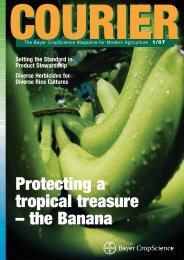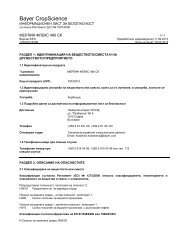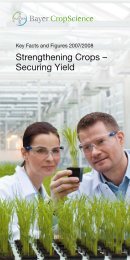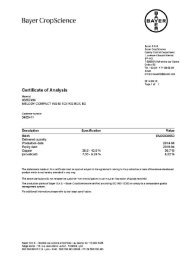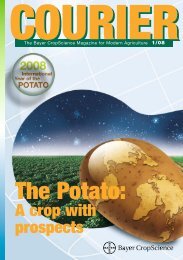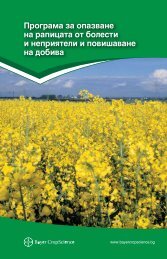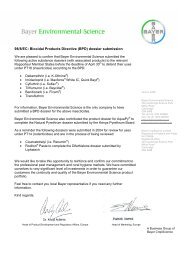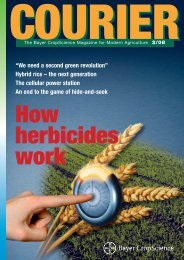For healthy potatoes - Bayer CropScience
For healthy potatoes - Bayer CropScience
For healthy potatoes - Bayer CropScience
Create successful ePaper yourself
Turn your PDF publications into a flip-book with our unique Google optimized e-Paper software.
ment. This can only occur if the recommended<br />
(and registered) rate is applied<br />
accurately. Careful calibration, maintenance<br />
and operation of the seed-treatment<br />
equipment are essential for achieving this;<br />
but other factors also play a major role,<br />
including the physico-chemical properties<br />
of the product; and the technical purity of<br />
the seed lot. The same parameters also<br />
determine how evenly the seed-treatment<br />
product is applied across the individual<br />
seeds. It is often possible to trace back a<br />
particular distribution pattern of a product<br />
to a particular combination of personnel<br />
and equipment. Graphical representation<br />
of the measured coverage of hundreds of<br />
individual seeds shows that a certain proportion<br />
of seeds always receives either significantly<br />
more, or significantly less than<br />
the target amount. This means that under<br />
practical conditions, every seed lot<br />
inevitably contains a certain number of<br />
over- or under-treated seeds. Even though<br />
the safety margin that has been incorporated<br />
into a product’s recommended application<br />
rate means that problems rarely<br />
arise in a crop grown from unevenlytreated<br />
seed, the consequences of intentional<br />
under-treating of seeds are often<br />
underestimated.<br />
Seed-treatment – an insurance<br />
policy for the farmer<br />
The pressure to continually decrease costs<br />
in cereal production has led to a situation<br />
in which various types of seed-treatment<br />
product are available that differ not only in<br />
terms of price, but also in terms of spectrum-of-action.<br />
This necessitates careful<br />
cost-benefit analysis: using a product containing<br />
a single active substance – and thus<br />
with a limited spectrum-of-action – is<br />
probably appropriate for (apparently) noninfected<br />
or only slightly-infected seeds<br />
lots, although the risk remains difficult to<br />
calculate. These products lack the versatility<br />
of premium products, which tend to<br />
maintain their broad activity even if unforeseen<br />
bad weather occurs, or if the risk<br />
of infection is higher than anticipated. The<br />
potential for efficacy offered by broadspectrum<br />
products under problematic conditions<br />
represents a cost-benefit investment<br />
that is probably unmatched by any<br />
other crop protection measure.<br />
Seed treatment should therefore not<br />
only be judged on the basis of cost. It<br />
should also be considered as an insurance<br />
policy, and this is reflected in the higher<br />
price paid for treated seed.<br />
Achieving an optimal seed-treatment<br />
that supports effective cereal cultivation<br />
depends on the use of high-quality products:<br />
these must show a spectrum-of-action<br />
and technical properties that meet the most<br />
demanding modern standards. ■<br />
Distribution of seed-treatment product across 100 seeds with 100% application rate<br />
Number of seeds<br />
Distribution of seed-treatment product across 100 seeds with 80% application rate<br />
Number of seeds<br />
25<br />
20<br />
15<br />
10<br />
5<br />
0<br />
25<br />
20<br />
15<br />
10<br />
5<br />
0<br />
1 2 5 4<br />
5<br />
1 2 5 4<br />
5<br />
9<br />
22<br />
10<br />
6<br />
9<br />
11<br />
22<br />
4<br />
10<br />
35 45 55 65 75 85 95 105 115 125 135 145 155 160<br />
Coverage (%)<br />
7<br />
Fritz Brendler,<br />
Chamber of Agriculture, North Rhine-Westphalia,<br />
Crop protection service Bonn, Germany<br />
6<br />
4 3<br />
2<br />
35 45 55 65 75 85 95 105 115 125 135 145 155 160<br />
Coverage (%)<br />
11<br />
4<br />
7<br />
3<br />
4 3<br />
2<br />
acceptable limits<br />
unacceptable limits<br />
3<br />
acceptable limits<br />
unacceptable limits<br />
1 1<br />
1 1<br />
In the first example, the amount of seed-treatment applied corresponded to 100%<br />
of the recommended application rate. Here, 78% of seeds had a coverage that was<br />
within acceptable limits (the region between 80 and 120 % coverage, blue bars).<br />
In the second example, only 80% of the recommended application rate was applied.<br />
The result: the proportion of seeds receiving coverage within the acceptable limits was<br />
reduced almost by half, to 40%. Coverage was too low for the majority (58%) of seeds.<br />
2/06 COURIER 31





